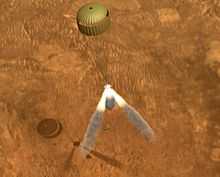Juan R. Cruz
| Dr. Juan R. Cruz | |
|---|---|
 | |
| Born |
January 5, 1946 Puerto Rico |
| Nationality | Puerto Rican |
| Occupation | aerospace engineer |
|
Notes Cruz was among the aerospace engineers from NASA Langley who worked on development of the parachute which helped slow the spacecraft during entry, descent and landing. | |
Dr. Juan R. Cruz, Ph.D., (born: January 5, 1946) is a Puerto Rican aerospace engineer who played an instrumental role in the design and development of the Mars Exploration Rover (MER) and Mars Science Laboratory (MSL) parachute.[1]
Early years
Cruz was born and raised in Puerto Rico. After earning a B.S. (Bachelor of Science) in Aeronautics and Astronautics from the Massachusetts Institute of Technology, he briefly worked at Beech Aircraft Corporation in Wichita, KS;[2] he then went on to earn a Ph.D. from Virginia Tech in aerospace engineering. During his years at MIT he was involved with the Monarch[3] and Daedalus human powered aircraft teams.[2][4]
Career in NASA
Cruz is a senior aerospace engineer in the Exploration Systems Engineering Branch at the NASA Langley Research Center in Hampton, Virginia. His responsibilities are focused on research and development of entry, descent, and landing (EDL) systems for robotic and human exploration missions. He was a member of the highly successful Mars Exploration Rover (MER) and Mars Science laboratory (MSL) projects that placed rovers on the surface of Mars in 2004 and 2012. His contributions to the MER and MSL projects centered on the design and qualification of the supersonic parachute.[1][5]
Mars Exploration Rover Mission

The MER-A rover, Spirit, was launched on June 10, 2003 at 17:59 UTC, and MER-B, Opportunity, on July 7, 2003. Spirit landed in Gusev crater on January 4, 2004 and Opportunity landed in the Meridiani Planum on the opposite side of Mars from Spirit, on January 25, 2004. Cruz was among the scientists from Langley who helped develop the parachute which helped slow the spacecraft during entry, descent and landing.
According to Cruz:"There are challenges to testing these parachutes because we can not test it at exactly the right conditions. Earth's atmosphere is the one we have to work with and the Martian atmosphere is very different, so you have to make adjustments in how you test the parachute. Another issue is the wind tunnel models we used in our tests were ten-percent scale models, about five feet in diameter".[6]
Cruz is also a member of the Phoenix (Mars 2007), Mars Science Laboratory (Mars 2011),[7] and Crew Exploration Vehicle EDL teams. He has undertaken research on advanced missions to Mars, including robotic airplanes, as well as having been a technical reviewer for the Genesis, Huygens, and Stardust missions. Prior to his involvement with exploration programs he conducted research on high-altitude unmanned aircraft.[5]
See also
- List of famous Puerto Ricans
- Puerto Rican scientists and inventors
- List of Puerto Ricans in the United States Space Program
References
- ↑ 1.0 1.1 Denise Lineberry, Langley is 'All Systems Go' to Make History on Mars, NASA, 07.16.12 (Accessed Nov. 13 2012)
- ↑ 2.0 2.1 Joan Ackermann-Blount and William Oscar Johnson, Winging Into History, Sports Illustrated, May 02, 1988 (accessed Nov. 13 2012)
- ↑ Geoffrey A. Landis, Human Powered Aircraft - Monarch Crew (accessed Nov. 13 2012)
- ↑ Hispanics@NASA LaRC Employees' Achievements
- ↑ 5.0 5.1 MIT MUSEUM PRESS RELEASE
- ↑ NASA News
- ↑ Denise Lineberry, Getting Curiosity to Mars, One Simulation at a Time, NASA, 08.02.12 (Accessed Nov. 13 2012)